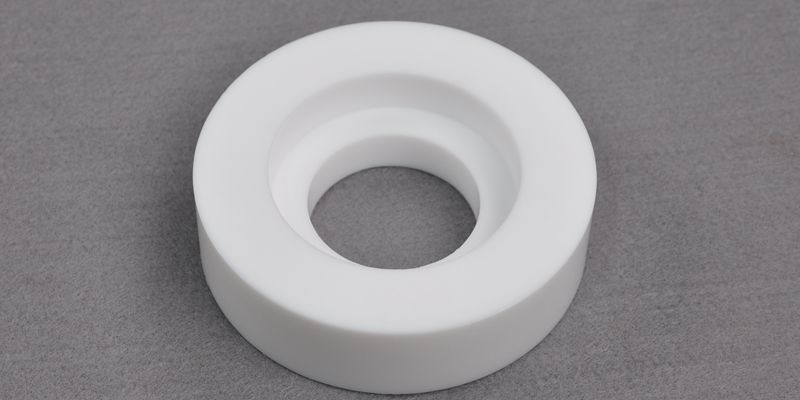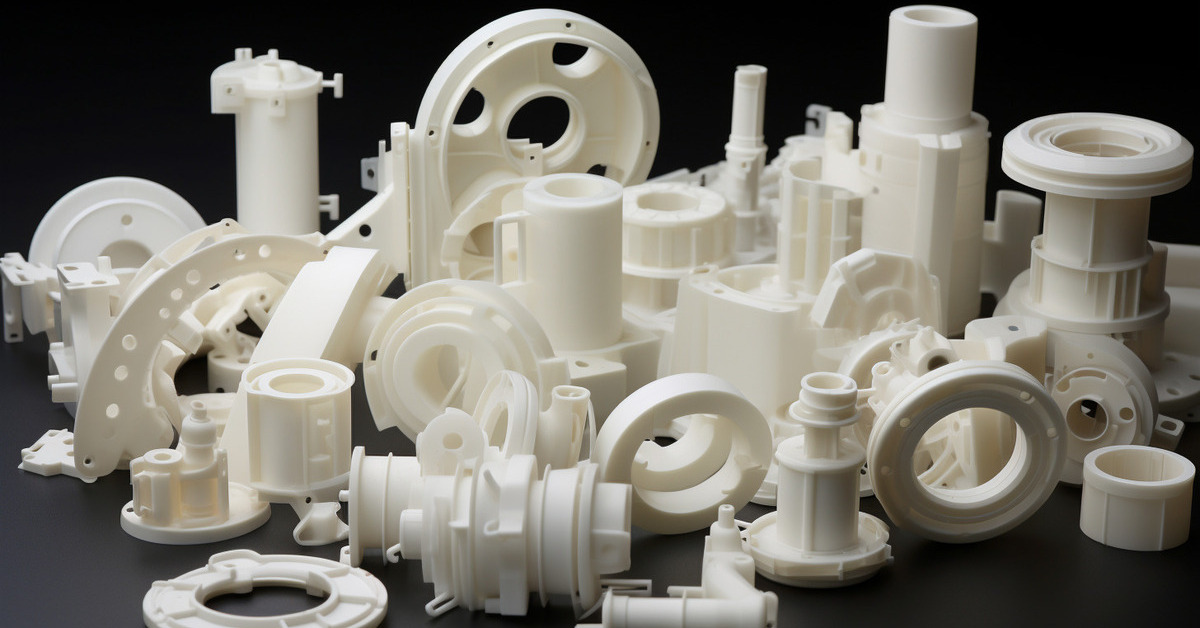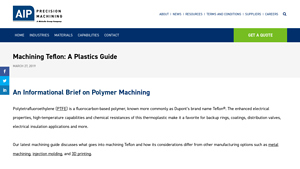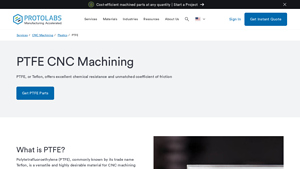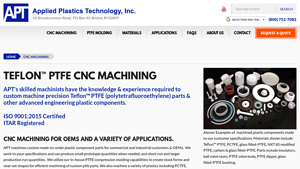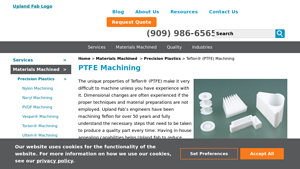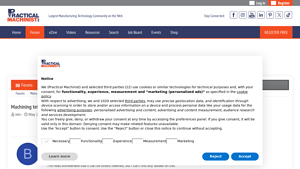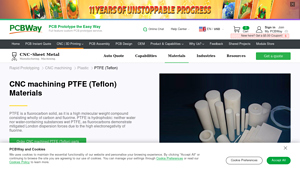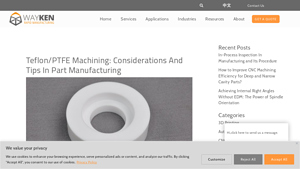Machined Teflon Guide: Type, Cost, Top List…
Introduction: Navigating the Global Market for machined teflon
In today’s competitive landscape, sourcing high-quality machined Teflon components presents significant challenges for B2B buyers across diverse industries. As a leading thermoplastic known for its exceptional chemical resistance and thermal stability, Polytetrafluoroethylene (PTFE) offers unique benefits that are crucial for applications in sectors ranging from aerospace to food processing. However, navigating the complexities of material specifications, machining processes, and supplier reliability can be daunting, particularly for international buyers from regions such as Africa, South America, the Middle East, and Europe, including countries like Saudi Arabia and Nigeria.
This comprehensive guide aims to empower B2B buyers by providing essential insights into the world of machined Teflon. It covers the various types of PTFE, their applications, and the nuances of machining techniques that can impact performance and cost. Additionally, we delve into best practices for vetting suppliers, understanding pricing structures, and ensuring quality control, which are vital for making informed purchasing decisions. By equipping international buyers with actionable knowledge and strategic considerations, this guide facilitates a smoother procurement process, enabling businesses to leverage the advantages of machined Teflon effectively. Whether you are seeking to enhance product performance or streamline production, understanding the global market for machined Teflon is key to achieving your operational goals.
Understanding machined teflon Types and Variations
| Type Name | Key Distinguishing Features | Primary B2B Applications | Brief Pros & Cons for Buyers |
|---|---|---|---|
| Unfilled PTFE | Highest purity, excellent electrical insulation | Aerospace, food processing, pharmaceuticals | Pros: Superior chemical resistance, high purity. Cons: Higher cost, limited mechanical strength. |
| Mechanical Grade PTFE | Cost-effective, reprocessed PTFE | General industrial applications | Pros: Economical, good compressive strength. Cons: Not suitable for high-purity applications. |
| Glass-Filled PTFE | Enhanced strength and reduced deformation | Valve seats, bearings, seals | Pros: Improved mechanical properties, lower thermal expansion. Cons: More expensive, may be less chemically resistant. |
| Carbon-Filled PTFE | Enhanced wear resistance, lower friction | Bearings, bushings, seals | Pros: Excellent durability, good for high-load applications. Cons: Reduced chemical resistance compared to unfilled PTFE. |
| PFA (Perfluoroalkoxy) | Similar to PTFE, better non-stick properties | Coatings, food processing, chemical handling | Pros: Superior non-stick characteristics. Cons: Softer, less abrasion-resistant than PTFE. |
What Are the Characteristics of Unfilled PTFE for B2B Buyers?
Unfilled PTFE, known for its exceptional purity and electrical insulation properties, is ideal for applications requiring high chemical resistance, such as aerospace and pharmaceuticals. Its ability to withstand extreme temperatures from -450°F to +500°F (-267.7°C to +260°C) makes it a versatile choice. However, buyers should consider its higher cost and relatively low mechanical strength, which may not be suitable for all industrial applications.
How Does Mechanical Grade PTFE Compare in Cost and Performance?
Mechanical grade PTFE is a reprocessed variant that offers a more economical solution for various industrial applications. While it provides good compressive strength and wear resistance, it lacks the high purity levels of unfilled PTFE. This makes it suitable for general applications where extreme conditions are not a primary concern. Buyers should weigh its cost benefits against the potential need for higher-grade materials in critical applications.
What Advantages Do Glass-Filled PTFE Offer for Industrial Uses?
Glass-filled PTFE enhances the mechanical properties of standard PTFE, making it suitable for demanding applications like valve seats and bearings. This variant exhibits lower thermal expansion and improved strength, which are crucial in high-stress environments. However, buyers should note that while it offers better durability, it may be more expensive and could present reduced chemical resistance compared to unfilled PTFE.
Why Choose Carbon-Filled PTFE for High-Load Applications?
Carbon-filled PTFE is engineered for superior wear resistance and lower friction, making it an excellent choice for bearings and bushings in high-load scenarios. This type offers enhanced durability, which can lead to longer service life and reduced maintenance costs. However, it’s important for buyers to consider that carbon-filled PTFE may have diminished chemical resistance compared to unfilled variants, requiring careful evaluation of application needs.
What Are the Unique Properties of PFA for B2B Applications?
PFA, or Perfluoroalkoxy, is a fluoropolymer similar to PTFE but with enhanced non-stick properties, making it particularly useful in food processing and chemical handling. Its unique characteristics allow for easy cleaning and maintenance, which is a significant advantage in industries requiring hygiene. However, buyers should be aware that PFA is softer and less abrasion-resistant than PTFE, which may affect its suitability in certain high-wear applications.
Key Industrial Applications of machined teflon
| Industry/Sector | Specific Application of machined teflon | Value/Benefit for the Business | Key Sourcing Considerations for this Application |
|---|---|---|---|
| Aerospace | Insulation for wiring and electrical components | Enhanced safety and reliability in high-stress environments | Certification standards for aerospace materials, weight considerations |
| Chemical Processing | Seals and gaskets in pumps and valves | Resistance to corrosive chemicals, reducing downtime | Chemical compatibility, temperature tolerance, and custom sizing |
| Food Processing | Bushings and bearings in food machinery | Compliance with food safety regulations, longevity of equipment | FDA compliance, ease of cleaning, and wear resistance |
| Medical Devices | Components for surgical instruments and implants | High purity and biocompatibility for patient safety | Quality certifications, material traceability, and precision machining |
| Oil and Gas | Liners and seals for pipelines and valves | Reduced maintenance costs and improved operational efficiency | Resistance to extreme temperatures and pressures, material sourcing from certified suppliers |
How is Machined Teflon Used in Aerospace Applications?
In the aerospace sector, machined Teflon is crucial for insulation in wiring and electrical components. Its exceptional thermal stability and chemical resistance ensure the safe operation of electrical systems under extreme conditions. International buyers, particularly in regions like Europe and the Middle East, must prioritize suppliers who meet strict aerospace certification standards and understand the importance of weight reduction in component manufacturing.
What Role Does Machined Teflon Play in Chemical Processing?
Machined Teflon is widely utilized for seals and gaskets in pumps and valves within chemical processing plants. Its resistance to corrosive chemicals helps prevent leaks and equipment failure, thus minimizing downtime. When sourcing Teflon components, businesses in Africa and South America should focus on suppliers who can provide custom sizing and confirm the chemical compatibility of materials to ensure optimal performance in their specific applications.
How is Machined Teflon Beneficial in Food Processing?
In the food processing industry, machined Teflon components such as bushings and bearings are essential for machinery that meets food safety regulations. Teflon’s non-stick properties and ease of cleaning contribute to operational efficiency and compliance with health standards. Buyers in regions like Nigeria and Saudi Arabia should ensure that suppliers offer FDA-compliant materials and can provide documentation regarding wear resistance and maintenance practices.
Why is Machined Teflon Important for Medical Devices?
Machined Teflon is commonly used in the production of surgical instruments and medical implants, where high purity and biocompatibility are critical. Its chemical inertness and ability to withstand sterilization processes make it a preferred choice. B2B buyers in the medical field must look for suppliers who can guarantee quality certifications and provide material traceability to ensure patient safety.
How Does Machined Teflon Enhance Oil and Gas Operations?
In the oil and gas industry, machined Teflon is employed for liners and seals in pipelines and valves. Its ability to withstand extreme temperatures and pressures reduces maintenance costs and enhances operational efficiency. Companies sourcing Teflon components in this sector should prioritize suppliers with a proven track record in providing materials that meet the rigorous demands of oil and gas applications, ensuring reliability and performance in harsh environments.
3 Common User Pain Points for ‘machined teflon’ & Their Solutions
Scenario 1: Difficulty Achieving Tight Tolerances in Machined Teflon Parts
The Problem: B2B buyers often face challenges when it comes to achieving tight tolerances in machined Teflon components. Due to Teflon’s high coefficient of thermal expansion and tendency to undergo stress creep, even minor fluctuations in temperature can lead to dimensional inaccuracies. This can result in parts not fitting properly, which is particularly problematic in applications such as aerospace or medical devices where precision is critical. Buyers may feel frustrated and anxious about the potential for increased production costs and delayed timelines if these tolerances cannot be reliably met.
The Solution: To overcome the challenge of tight tolerances, it is essential for buyers to work closely with manufacturers who specialize in machining Teflon. Before production begins, clearly communicate the required tolerances and the intended application of the parts. Request that the manufacturer employ a combination of advanced machining techniques, such as CNC machining with sharp tools and appropriate coolant strategies, which can minimize thermal expansion issues. Additionally, consider specifying the use of modified PTFE grades that exhibit enhanced dimensional stability under load. Post-machining processes such as annealing can further relieve internal stresses, ensuring that the final product maintains its shape and dimensions during use.
Scenario 2: Surface Finish Quality Issues During Teflon Machining
The Problem: Another common pain point for B2B buyers is achieving the desired surface finish on machined Teflon parts. Due to Teflon’s soft nature, machining can result in burrs, rough surfaces, and other imperfections that may compromise the performance of the component, particularly in applications requiring low friction or hygienic surfaces, such as food processing equipment. Buyers may find themselves disappointed and facing additional costs for rework or secondary finishing processes.
The Solution: To address surface finish quality, buyers should prioritize working with manufacturers who have extensive experience in machining Teflon. Providing detailed specifications for the desired surface finish upfront can guide the machining process effectively. Utilizing sharp cutting tools and implementing cooling techniques, such as water-soluble coolants, can help achieve better finishes and reduce burr formation. Furthermore, consider integrating a deburring strategy into the production process. Techniques such as using advanced freezing methods can harden the Teflon temporarily, making it easier to achieve a clean surface finish during deburring. Finally, discussing the potential for post-processing treatments like sanding or polishing can help ensure the final product meets all performance standards.
Scenario 3: Limited Availability of Suitable Teflon Grades
The Problem: B2B buyers often encounter issues with the availability of specific grades of Teflon that are suitable for their applications. With various grades offering different properties, such as mechanical strength, chemical resistance, and thermal stability, finding the right grade can be a daunting task. Buyers may feel overwhelmed by the complexity of selecting the right material, leading to concerns about sourcing delays or suboptimal performance in their applications.
The Solution: To navigate the challenge of selecting the right Teflon grade, buyers should first assess their specific application requirements, including environmental conditions, mechanical loads, and any regulatory standards that must be met. Once these parameters are established, collaborating with a knowledgeable supplier can simplify the process. Suppliers who specialize in Teflon can provide insights into the various grades available, such as unfilled PTFE for high purity applications or filled grades for enhanced mechanical properties. Establishing a relationship with a supplier that has a robust inventory and can offer custom solutions will help ensure timely access to the right materials. Additionally, consider requesting samples of different grades for testing prior to large-scale production, allowing for a hands-on evaluation of their suitability for your specific needs.
Strategic Material Selection Guide for machined teflon
What Are the Key Properties of Machined Teflon?
Machined Teflon, or PTFE, is renowned for its exceptional properties, making it suitable for various industrial applications. It exhibits remarkable thermal stability, with a temperature range from -260°C to 260°C, and is chemically inert, providing outstanding resistance to a wide array of solvents, acids, and bases. Additionally, its low coefficient of friction and excellent electrical insulation properties make it a preferred choice in sectors such as aerospace, food processing, and medical devices.
What Are the Pros and Cons of Using Machined Teflon?
While Teflon offers numerous advantages, it also has limitations that need to be considered. The primary benefits include its durability in harsh chemical environments, ease of machining due to its softness, and food-safe properties, which are crucial for applications in the food industry. However, Teflon’s mechanical properties are relatively poor compared to other materials, leading to challenges in achieving tight tolerances and increased susceptibility to stress creep. Additionally, its high coefficient of thermal expansion can complicate its use in high-precision applications.
How Do Different Grades of Teflon Impact Application Suitability?
Different grades of Teflon, such as virgin PTFE, glass-filled PTFE, and carbon-filled PTFE, offer varying performance characteristics. Virgin PTFE is ideal for applications requiring high purity and excellent electrical insulation. In contrast, glass-filled PTFE enhances compressive strength and wear resistance, making it suitable for more demanding applications. Carbon-filled PTFE provides improved wear resistance and lower friction, which is beneficial in dynamic applications. International B2B buyers should consider these grades based on specific media compatibility and operational requirements.
What Should International B2B Buyers Consider When Selecting Machined Teflon?
For international B2B buyers, particularly in regions like Africa, South America, the Middle East, and Europe, compliance with local and international standards is critical. Standards such as ASTM, DIN, and JIS govern material properties and performance metrics. Buyers should also be aware of regional preferences and availability of specific grades of Teflon. Additionally, understanding the supply chain dynamics, including lead times and shipping costs, is essential for making informed purchasing decisions.
Summary Table of Machined Teflon Materials
| Material | Typical Use Case for machined teflon | Key Advantage | Key Disadvantage/Limitation | Relative Cost (Low/Med/High) |
|---|---|---|---|---|
| Virgin PTFE | Electrical insulation, seals, bearings | Excellent chemical resistance and purity | Poor mechanical strength and tight tolerance | High |
| Glass-Filled PTFE | High-load bearings, bushings | Increased compressive strength and wear resistance | Limited flexibility and higher cost | Medium |
| Carbon-Filled PTFE | Dynamic seals, wear strips | Reduced friction and improved wear resistance | Less chemical resistance than virgin PTFE | Medium |
| Modified PTFE (e.g., PFA) | Non-stick coatings, food processing | Superior non-stick properties | Generally softer, less abrasion-resistant | Medium |
This strategic material selection guide provides a comprehensive overview of machined Teflon, highlighting its properties, applications, and considerations for international B2B buyers. Understanding these factors will enable businesses to make informed decisions that align with their operational needs and compliance requirements.
In-depth Look: Manufacturing Processes and Quality Assurance for machined teflon
What Are the Key Stages in the Manufacturing Process for Machined Teflon?
The manufacturing process for machined Teflon (PTFE) involves several critical stages that ensure the final product meets the specific requirements of various applications. Understanding these stages is essential for B2B buyers looking to procure high-quality Teflon components.
1. Material Preparation
The first step in the manufacturing process involves sourcing high-quality PTFE resin. This material is typically available in different grades, such as virgin PTFE, filled PTFE (like glass-filled or carbon-filled), and mechanical grade PTFE. The choice of grade depends on the intended application and performance requirements. Once the appropriate material is selected, it is cut into manageable shapes, often in the form of sheets or rods, to facilitate machining.
2. Machining and Forming Techniques
CNC machining is the primary technique used to shape Teflon components. The soft, ductile nature of PTFE allows for efficient machining; however, it requires specialized tools and techniques to prevent deformation and achieve precise tolerances. Key machining operations include:
- Turning: This process is used to create cylindrical parts and involves rotating the Teflon material against a cutting tool.
- Milling: Flat surfaces and complex geometries can be produced using milling machines, allowing for intricate designs.
- Drilling: Holes for fittings and other components can be accurately drilled into Teflon parts.
To enhance machining efficiency and surface finish, it is essential to employ sharp cutting tools and use appropriate cooling methods, such as water-soluble coolants. These measures help mitigate the risk of thermal distortion and tool clogging.
3. Assembly
For applications requiring multiple components, assembly is the next crucial stage. Depending on the design, Teflon parts may need to be bonded or fitted with other materials. Adhesives compatible with PTFE or mechanical fastening techniques are commonly used. Careful attention to assembly procedures is necessary to ensure the integrity and functionality of the final product.
4. Finishing Processes
Finishing techniques are applied to enhance the surface quality of machined Teflon parts. Common methods include deburring, which removes sharp edges and imperfections that may arise during machining. Other finishing options may involve surface polishing or applying additional coatings for specific applications. The choice of finishing technique is influenced by the end-use requirements and industry standards.
How Is Quality Assurance Implemented in Machined Teflon Production?
Quality assurance is paramount in the manufacturing of machined Teflon components, particularly given the diverse industries that utilize these parts, including aerospace, medical, and food processing. Implementing robust quality control measures helps ensure that products meet international and industry-specific standards.
1. What Are the Relevant International Standards for Teflon Machining?
B2B buyers should look for manufacturers that comply with international quality standards such as ISO 9001, which outlines criteria for a quality management system. Adhering to these standards demonstrates a commitment to continuous improvement and customer satisfaction. Additionally, industry-specific certifications may be required:
- CE Marking: Indicates compliance with European health, safety, and environmental protection standards.
- API Certification: Essential for manufacturers producing components for the oil and gas industry, ensuring adherence to safety and reliability standards.
2. What Are the Key Quality Control Checkpoints?
Quality control checkpoints are integrated throughout the manufacturing process to ensure that each component meets the required specifications:
- Incoming Quality Control (IQC): Raw materials are inspected upon receipt to verify that they meet specified standards.
- In-Process Quality Control (IPQC): Continuous monitoring occurs during machining and assembly to identify defects early in the process.
- Final Quality Control (FQC): Finished products undergo thorough testing and inspection before shipment to ensure they meet all quality requirements.
3. What Testing Methods Are Commonly Used?
To validate the quality and performance of machined Teflon components, various testing methods may be employed, including:
- Dimensional Inspection: Using precision measuring tools to verify that parts conform to specified dimensions and tolerances.
- Mechanical Testing: Assessing properties such as tensile strength and elongation to ensure the material can withstand operational conditions.
- Thermal Stability Testing: Evaluating the performance of Teflon components under extreme temperatures to ensure reliability in high-temperature applications.
How Can B2B Buyers Verify Supplier Quality Control Practices?
For international B2B buyers, particularly those from regions like Africa, South America, the Middle East, and Europe, verifying a supplier’s quality control practices is critical. Here are several strategies to ensure confidence in the manufacturing partner:
1. Conducting Supplier Audits
Regular audits of potential suppliers can provide insights into their quality management systems and manufacturing capabilities. During an audit, buyers can assess compliance with international standards and evaluate the effectiveness of the supplier’s quality control processes.
2. Requesting Quality Assurance Documentation
Buyers should request and review quality assurance documentation, including certificates of compliance with relevant standards (e.g., ISO, CE) and detailed reports from quality control checkpoints. This documentation can provide assurance of the supplier’s commitment to quality.
3. Utilizing Third-Party Inspection Services
Engaging third-party inspection services can offer an impartial evaluation of the supplier’s manufacturing processes and quality control practices. These services can conduct on-site inspections and testing to validate compliance with specified standards.
What Are the Quality Control Nuances for International Buyers?
International buyers must navigate specific nuances in quality control when sourcing machined Teflon components. Factors to consider include:
- Cultural Differences: Understanding local manufacturing practices and quality expectations can help buyers communicate effectively with suppliers.
- Regulatory Compliance: Different regions may have varying regulations regarding materials and manufacturing processes. Buyers should ensure that suppliers meet the regulatory requirements specific to their market.
- Supply Chain Reliability: Establishing a reliable supply chain is essential for maintaining quality. Buyers should evaluate the supplier’s logistics capabilities and track record for on-time delivery.
By understanding the manufacturing processes and quality assurance practices involved in machining Teflon, B2B buyers can make informed decisions when selecting suppliers and ensure the production of high-quality components tailored to their specific needs.
Practical Sourcing Guide: A Step-by-Step Checklist for ‘machined teflon’
Introduction
This guide provides a structured checklist for B2B buyers seeking to procure machined Teflon (PTFE) components. With its unique properties and applications, it is essential to approach sourcing with a clear understanding of technical requirements, supplier capabilities, and market conditions. By following these steps, you can ensure that you select the right materials and suppliers for your projects.
Step 1: Define Your Technical Specifications
Establishing precise technical specifications is vital for ensuring that the machined Teflon parts meet your operational requirements. Consider factors such as dimensions, tolerances, and application-specific properties like chemical resistance or thermal stability. The more detailed your specifications, the better suppliers can tailor their offerings to your needs.
Step 2: Research and Identify Reputable Suppliers
Conduct thorough research to identify potential suppliers with experience in machining Teflon. Look for companies that specialize in PTFE and have a proven track record in your industry. Online reviews, industry forums, and trade shows can provide insights into supplier reliability and product quality.
Step 3: Evaluate Supplier Certifications and Capabilities
Before making a decision, assess the certifications and capabilities of your shortlisted suppliers. Relevant certifications such as ISO 9001 indicate adherence to quality management standards. Additionally, evaluate their machining capabilities, including equipment used, production capacity, and expertise in handling PTFE’s unique properties.
Step 4: Request Samples and Prototypes
To ensure the quality and suitability of the machined Teflon parts, request samples or prototypes from potential suppliers. This allows you to evaluate the physical attributes and performance characteristics of the material in real-world applications. Make sure to test for critical factors such as dimensional accuracy and chemical resistance.
Step 5: Understand Pricing Structures and Terms
Engage suppliers in discussions about pricing structures and terms of sale. Understand the cost implications of different grades of Teflon, machining processes, and any additional services like assembly or finishing. Transparent pricing will help you make informed budget decisions and avoid unexpected costs later on.
Step 6: Verify Lead Times and Delivery Options
Confirm lead times and delivery options with your selected suppliers. Teflon machining can involve longer production times due to the material’s properties and the complexity of the machining process. Ensure that the supplier can meet your project timelines and has reliable logistics in place to avoid delays.
Step 7: Establish a Communication Plan
Effective communication is essential for a successful sourcing relationship. Set clear expectations regarding updates, feedback loops, and problem resolution processes. A solid communication plan will facilitate collaboration and help address any issues that arise during production or delivery.
By following this checklist, B2B buyers can streamline the procurement process for machined Teflon components, ensuring that they receive high-quality products that meet their specific needs.
Comprehensive Cost and Pricing Analysis for machined teflon Sourcing
What Are the Key Cost Components in Machined Teflon Sourcing?
When sourcing machined Teflon, understanding the cost structure is crucial for B2B buyers. The total cost comprises several components, including materials, labor, manufacturing overhead, tooling, quality control (QC), logistics, and supplier margins.
-
Materials: The primary cost driver in Teflon machining is the raw material itself. Polytetrafluoroethylene (PTFE) can vary in price based on its grade and purity. For instance, virgin grade PTFE is more expensive than reprocessed variants but offers superior performance for critical applications.
-
Labor: Skilled labor is essential for machining Teflon due to its unique properties. Operators must be trained in techniques specific to Teflon to mitigate risks like burr formation and ensure precision. Labor costs can vary significantly based on the region and the complexity of the machining process.
-
Manufacturing Overhead: This includes costs associated with facility operation, utilities, equipment maintenance, and administrative expenses. The overhead cost can fluctuate based on the manufacturing location, impacting the final pricing of machined Teflon.
-
Tooling: Given Teflon’s softness, specialized tooling is required to achieve desired tolerances and surface finishes. Tooling costs can be significant, especially if custom designs or advanced techniques (like cryogenic deburring) are employed.
-
Quality Control: Rigorous QC is vital to ensure that machined components meet industry standards and specifications. The costs associated with testing and certification can vary based on the complexity of the parts and the required certifications.
-
Logistics: Shipping costs are influenced by the distance from the manufacturing facility to the buyer, as well as the chosen Incoterms. International shipments may involve additional customs duties and tariffs, which should be factored into the total cost.
-
Margin: Suppliers typically include a margin that reflects their operational risk, expertise, and market demand. This margin can vary widely, affecting the overall pricing structure.
How Do Price Influencers Impact the Cost of Machined Teflon?
Several factors can influence the pricing of machined Teflon, making it essential for buyers to be aware of these elements.
-
Volume/MOQ: Larger orders often result in lower per-unit costs due to economies of scale. Buyers should negotiate minimum order quantities (MOQs) to optimize their procurement strategy.
-
Specifications and Customization: Custom designs and specific tolerances can significantly increase costs. Buyers should clearly define their requirements to avoid unexpected expenses later in the process.
-
Materials and Quality Certifications: Higher-grade materials and certifications (such as FDA compliance for food applications) can increase costs. Buyers must balance their need for quality against their budget constraints.
-
Supplier Factors: The reputation and experience of the supplier can affect pricing. Established suppliers may charge higher rates due to their expertise and reliability, while newer entrants might offer lower prices to gain market share.
-
Incoterms: The choice of Incoterms impacts the cost structure, as they determine who is responsible for shipping and insurance. Buyers should select terms that align with their logistics capabilities and risk tolerance.
What Negotiation and Cost-Efficiency Tips Should International B2B Buyers Consider?
For international B2B buyers, particularly those from regions like Africa, South America, the Middle East, and Europe, effective negotiation and cost-efficiency strategies are vital.
-
Understand Total Cost of Ownership (TCO): Beyond the initial purchase price, consider all costs associated with the product over its lifecycle, including maintenance, logistics, and potential downtime. This holistic view can lead to more informed purchasing decisions.
-
Leverage Volume Discounts: If possible, consolidate orders across multiple needs to increase volume and negotiate better pricing. Suppliers often appreciate larger commitments and may provide favorable terms.
-
Explore Alternative Suppliers: Diversifying your supplier base can lead to better pricing and reduced risk. Evaluate suppliers from different regions to find cost-effective solutions without compromising quality.
-
Be Clear on Specifications: To avoid costly misunderstandings, provide detailed specifications and requirements upfront. This clarity can reduce the likelihood of changes during production, which often incur additional costs.
-
Stay Informed on Market Trends: Understanding fluctuations in raw material prices and market demand can empower buyers during negotiations, allowing them to secure better pricing.
Disclaimer on Pricing
The prices discussed in this analysis are indicative and can vary based on market conditions, supplier negotiations, and specific project requirements. It is recommended that buyers conduct thorough market research and obtain multiple quotes to ensure competitive pricing.
Alternatives Analysis: Comparing machined teflon With Other Solutions
Exploring Alternative Solutions to Machined Teflon
In the world of industrial applications, selecting the right material or method can significantly influence performance, cost, and overall project success. While machined Teflon (PTFE) is renowned for its chemical resistance and low friction properties, other viable alternatives exist that may better suit specific needs. This analysis compares machined Teflon with two prominent alternatives: PFA (Perfluoroalkoxy) and Nylon.
Comparison Table
| Comparison Aspect | Machined Teflon | Alternative 1 Name (PFA) | Alternative 2 Name (Nylon) |
|---|---|---|---|
| Performance | Excellent chemical resistance, low friction, high thermal stability | Superior non-stick properties, good chemical resistance, softer | High tensile strength, good wear resistance, less chemical resistance |
| Cost | Generally higher due to specialized machining | Moderate, often similar to Teflon | Lower cost, widely available |
| Ease of Implementation | Requires specialized machining techniques | Easier to machine than Teflon | Standard machining processes |
| Maintenance | Low maintenance; self-lubricating | Low maintenance, but softer | Moderate; may require regular checks for wear |
| Best Use Case | Aerospace, medical devices, food processing | Food processing, semiconductor manufacturing | General-purpose applications, automotive parts |
Detailed Breakdown of Alternatives
PFA (Perfluoroalkoxy)
PFA is a fluoropolymer similar to Teflon, noted for its excellent non-stick properties and chemical resistance. It is softer than Teflon, which can be an advantage in applications requiring flexibility. PFA’s easier machinability compared to Teflon allows for more straightforward production processes, making it a preferred choice in industries like food processing and semiconductor manufacturing. However, its lower abrasion resistance may limit its use in high-wear applications.
Nylon
Nylon is a versatile thermoplastic known for its high tensile strength and durability. While it does not offer the same level of chemical resistance as Teflon or PFA, it performs well in applications requiring mechanical strength, such as automotive parts and general-purpose components. The cost-effectiveness of Nylon makes it an attractive alternative for projects with budget constraints. However, it may require more maintenance to monitor wear and tear, especially in harsh environments.
Making the Right Choice for Your B2B Needs
When choosing between machined Teflon and its alternatives, B2B buyers should consider several factors, including the specific application requirements, budget constraints, and the environmental conditions the material will face. Machined Teflon is ideal for high-performance scenarios demanding chemical resistance and low friction, while PFA offers a softer, easier-to-machine option with similar benefits. On the other hand, Nylon presents a cost-effective solution for applications where mechanical strength is paramount. Understanding these differences will empower buyers to make informed decisions that align with their operational needs and project objectives.
Essential Technical Properties and Trade Terminology for machined teflon
What Are the Key Technical Properties of Machined Teflon?
When evaluating machined Teflon (PTFE), several critical specifications must be understood to ensure that the material meets the needs of your application. Below are some essential properties:
Material Grade
Teflon is available in various grades, each with unique characteristics. Virgin PTFE offers the highest purity and is chemically inert, making it ideal for sensitive applications like medical devices. Modified grades, such as glass-filled or carbon-filled PTFE, enhance specific properties, such as tensile strength or wear resistance. Selecting the right grade is crucial for performance, durability, and compliance with industry standards.
Tolerance
Tolerance refers to the allowable deviation from a specified dimension in machined parts. For Teflon, a typical achievable tolerance is around ±0.13 mm. Understanding tolerance is vital for B2B buyers, as tighter tolerances may require additional processes like annealing to relieve internal stresses, potentially increasing costs and lead times.
Coefficient of Friction
Teflon is known for its exceptionally low coefficient of friction, making it an excellent choice for applications where sliding or moving parts are involved. This property is particularly beneficial in industries such as aerospace and automotive, where reducing friction can improve efficiency and longevity of components.
Thermal Stability
Teflon exhibits thermal stability across a wide temperature range, from -260°C to 260°C. This characteristic allows it to maintain performance in extreme conditions, which is particularly important for applications in chemical processing or high-temperature environments. B2B buyers must consider thermal stability to avoid failures in critical applications.
Chemical Resistance
One of the standout features of Teflon is its chemical resistance. It can withstand a wide range of corrosive substances, making it suitable for use in industries like pharmaceuticals and food processing. Understanding this property is essential for ensuring that the material will perform adequately in its intended environment.
What Are Common Trade Terms Related to Machined Teflon?
Navigating the procurement and manufacturing landscape requires familiarity with specific jargon. Here are some common terms you should know:
OEM (Original Equipment Manufacturer)
An OEM refers to a company that produces parts or equipment that may be marketed by another manufacturer. In the context of machined Teflon, B2B buyers often collaborate with OEMs to ensure that the Teflon components meet their specific needs and standards.
MOQ (Minimum Order Quantity)
MOQ signifies the smallest quantity of a product that a supplier is willing to sell. Understanding MOQ is critical for B2B buyers, as it impacts inventory management and cost-effectiveness. Suppliers may have different MOQs based on the material grade and machining complexity.
RFQ (Request for Quotation)
An RFQ is a document sent to suppliers to request pricing and terms for specific products or services. For machined Teflon, issuing an RFQ can help buyers obtain competitive pricing and clarify lead times, thereby facilitating informed decision-making.
Incoterms (International Commercial Terms)
Incoterms are standardized trade terms that define the responsibilities of buyers and sellers in international transactions. For machined Teflon, understanding Incoterms is crucial for managing shipping costs, delivery timelines, and risk during transportation.
Lead Time
Lead time refers to the time it takes from placing an order to receiving the final product. In the context of machined Teflon, lead times can vary based on material availability, machining complexity, and post-processing requirements. Knowing lead times helps B2B buyers plan their projects effectively.
By grasping these technical properties and trade terms, B2B buyers can make informed decisions regarding machined Teflon, ensuring optimal performance and cost-effectiveness for their applications.
Navigating Market Dynamics and Sourcing Trends in the machined teflon Sector
What Are the Current Market Dynamics and Key Trends in the Machined Teflon Sector?
The machined Teflon sector is witnessing robust growth, driven by increasing demand across various industries, including aerospace, medical, and food processing. The unique properties of Polytetrafluoroethylene (PTFE), such as its chemical resistance and thermal stability, position it as a preferred choice for applications requiring high-performance materials. Internationally, buyers from regions like Africa, South America, the Middle East, and Europe are increasingly sourcing machined Teflon components to enhance product reliability and efficiency.
Emerging technologies such as advanced CNC machining and 3D printing are reshaping the sourcing landscape. These technologies enable precise manufacturing of Teflon parts, catering to specific application needs while reducing lead times. Additionally, the shift towards digital procurement platforms is facilitating easier access to suppliers and enhancing transparency in sourcing processes. As businesses seek to optimize their supply chains, understanding local market dynamics—including regulations, tariffs, and logistical challenges—becomes essential for international buyers.
Notably, the market is also seeing a trend towards customization, with manufacturers offering tailored solutions to meet unique specifications. This trend is particularly relevant for industries that require high tolerances and specialized features in machined Teflon components. As global supply chains become more interconnected, international buyers must stay informed about market fluctuations and emerging trends to make strategic sourcing decisions.
How Is Sustainability and Ethical Sourcing Addressed in the Machined Teflon Sector?
Sustainability is becoming a critical consideration for B2B buyers in the machined Teflon sector. The environmental impact of PTFE production and disposal raises concerns, prompting many companies to seek out suppliers that prioritize ethical sourcing practices. This includes ensuring compliance with environmental regulations and utilizing manufacturing processes that minimize waste and energy consumption.
Moreover, the demand for ‘green’ certifications is on the rise. Buyers are increasingly looking for suppliers that can demonstrate adherence to environmental standards, such as ISO 14001, which emphasizes effective environmental management systems. Companies that incorporate recycled materials or adopt eco-friendly manufacturing processes are gaining favor among environmentally conscious buyers.
In addition, the emphasis on transparent supply chains is reshaping sourcing strategies. Buyers are encouraged to conduct due diligence to ensure their suppliers maintain ethical labor practices and environmental stewardship. By prioritizing sustainability in their procurement processes, businesses not only enhance their brand reputation but also contribute to a more sustainable future in the machined Teflon sector.
What Is the Historical Context of Machined Teflon and Its Evolution in B2B Markets?
The history of Teflon dates back to its accidental discovery in 1938 by chemist Roy Plunkett. Initially used in military applications during World War II, its unique properties soon found broader applications across various industries. The introduction of CNC machining in the late 20th century revolutionized the processing of Teflon, allowing for the production of precise components that met the stringent demands of sectors like aerospace and medical devices.
Over the decades, the evolution of Teflon has been marked by innovations in formulations and processing techniques, leading to the development of modified grades of PTFE that offer enhanced performance characteristics. As global industries evolve and prioritize high-performance materials, the machined Teflon market continues to grow, adapting to new challenges and opportunities. This historical context is crucial for B2B buyers seeking to understand the material’s journey and its significance in today’s market landscape.
Frequently Asked Questions (FAQs) for B2B Buyers of machined teflon
-
1. How do I ensure the quality of machined Teflon products?
To ensure quality when sourcing machined Teflon products, it is crucial to conduct thorough supplier vetting. Look for manufacturers with certifications such as ISO 9001, which indicates a commitment to quality management systems. Request samples to evaluate craftsmanship and material properties. Additionally, inquire about their quality assurance processes, including testing methods for chemical resistance and dimensional accuracy. Establishing a clear communication channel regarding your specifications will also help ensure that the final products meet your expectations. -
2. What is the best machining process for Teflon components?
CNC machining is widely regarded as the best process for manufacturing Teflon components due to its precision and ability to produce complex shapes. The process allows for tight tolerances, typically around 0.13 mm, and minimizes the risk of deformation due to Teflon’s thermal stability. It’s essential to use sharp cutting tools and appropriate coolants, such as water-soluble options, to achieve optimal surface finishes. Understanding the unique characteristics of Teflon will help machinists avoid common pitfalls, such as burr formation. -
3. What are the typical applications for machined Teflon parts?
Machined Teflon parts are used in various industries due to their unique properties. Common applications include seals, bearings, bushings, valves, and insulators, particularly in sectors like aerospace, medical devices, and food processing. Teflon’s excellent chemical resistance and low friction make it suitable for environments where durability and reliability are critical. Before sourcing, ensure that the specific application requirements, such as temperature range and chemical exposure, align with the material properties of Teflon. -
4. How can I customize Teflon components for my specific needs?
Customization of Teflon components can be achieved by working closely with your supplier. Provide detailed specifications regarding dimensions, tolerances, and any specific performance requirements. Discuss the possibility of using modified grades of Teflon, such as glass-filled or carbon-filled variants, to enhance certain properties like strength or wear resistance. Many suppliers offer design assistance to ensure that the final product meets your operational needs, so leverage their expertise during the development process. -
5. What are the minimum order quantities (MOQs) for machined Teflon parts?
Minimum order quantities for machined Teflon parts can vary significantly among suppliers, depending on their production capabilities and the complexity of the parts. Generally, MOQs can range from a few pieces for custom prototypes to larger quantities for mass production. It’s advisable to discuss your specific needs with potential suppliers to understand their MOQ policies and explore options for smaller batches, especially if you are testing the market or developing new applications. -
6. What payment terms should I expect when sourcing machined Teflon?
Payment terms for sourcing machined Teflon can differ based on the supplier’s policies and your negotiation. Common terms include upfront deposits, typically ranging from 30% to 50%, with the balance due upon delivery. Some suppliers may offer net payment terms, allowing payment within a specified period post-delivery. Always clarify payment terms in advance and consider using secure payment methods that protect both parties, especially for international transactions. -
7. How do I manage logistics and shipping for international orders of Teflon components?
Managing logistics for international orders involves selecting reliable shipping partners and understanding customs regulations in both the exporting and importing countries. Ensure your supplier provides the necessary documentation, such as commercial invoices and certificates of origin, to facilitate smooth customs clearance. Discuss shipping options, including express services for urgent needs or freight forwarding for larger shipments. Establish clear communication with your supplier about timelines and potential delays to avoid disruptions in your supply chain. -
8. What are the key factors to consider when selecting a supplier for machined Teflon?
When selecting a supplier for machined Teflon, consider their experience and specialization in machining fluoropolymers. Evaluate their production capabilities, including technology and equipment used, to ensure they can meet your specifications. Check for customer reviews or case studies that demonstrate their reliability and quality. Additionally, inquire about their lead times, flexibility in production, and support services, such as design assistance or prototyping, to ensure a comprehensive partnership that aligns with your business goals.
Important Disclaimer & Terms of Use
⚠️ Important Disclaimer
The information provided in this guide, including content regarding manufacturers, technical specifications, and market analysis, is for informational and educational purposes only. It does not constitute professional procurement advice, financial advice, or legal advice.
While we have made every effort to ensure the accuracy and timeliness of the information, we are not responsible for any errors, omissions, or outdated information. Market conditions, company details, and technical standards are subject to change.
B2B buyers must conduct their own independent and thorough due diligence before making any purchasing decisions. This includes contacting suppliers directly, verifying certifications, requesting samples, and seeking professional consultation. The risk of relying on any information in this guide is borne solely by the reader.
Top 7 Machined Teflon Manufacturers & Suppliers List
1. AIP Precision – Teflon Machining Solutions
Domain: aipprecision.com
Registered: 2012 (13 years)
Introduction: Machining Teflon (PTFE) is a fluorocarbon-based polymer known for its enhanced electrical properties, high-temperature capabilities, and chemical resistances. It is commonly used in applications such as backup rings, coatings, distribution valves, and electrical insulation. Teflon is a semi-crystalline thermoplastic with excellent chemical resistance, sliding properties, UV resistance, hot water r…
2. Protolabs – PTFE CNC Machining Service
Domain: protolabs.com
Registered: 2006 (19 years)
Introduction: PTFE (Teflon) CNC Machining Service offers cost-efficient machined parts at any quantity. PTFE is a versatile fluoropolymer known for its non-stick and low-friction properties, making it ideal for applications requiring low coefficient of friction, such as bearings, bushings, and seals. Key benefits include low friction and wear resistance, high machinability, chemical and temperature resistance, …
3. Applied Plastics Technologies – Custom Teflon PTFE CNC Machining
Domain: ptfeparts.com
Registered: 2000 (25 years)
Introduction: Custom Teflon PTFE CNC Machining services offered by Applied Plastics Technologies. Key features include: ISO 9001:2015 Certified, ITAR Registered, CNC machining for OEMs, and a variety of applications. Capabilities include small prototype quantities, short run, and larger production runs. In-house PTFE compression molding for stock forms and near net shapes. Machining of various plastics includin…
4. Upland Fab – Teflon® CNC Machining
Domain: uplandfab.com
Registered: 1997 (28 years)
Introduction: Upland Fab specializes in Teflon® (PTFE) CNC machining, leveraging over 50 years of experience. Teflon® is known for its low coefficient of friction, making it ideal for wear applications, seals, and gaskets. It maintains good dimensional stability up to 500°F and is utilized in industries such as medical, aerospace, and semiconductor. Upland Fab offers in-house annealing capabilities to reduce th…
5. Practical Machinist – Teflon Machining Techniques
Domain: practicalmachinist.com
Registered: 2000 (25 years)
Introduction: Teflon (polytetrafluoroethylene, PTFE) is a polymer known for its instability and tendency to ‘cold flow’ under pressure. It has a high coefficient of thermal expansion, making it sensitive to heat during machining. Positive rake tools with sharp edges are recommended for better finishes and to reduce stress. Machining techniques include using 3M two-sided tape for stability and pre-heating Teflon…
6. PCBWay – CNC Machining in PTFE (Teflon)
Domain: pcbway.com
Registered: 2012 (13 years)
Introduction: CNC machining in PTFE (Teflon) offers high molecular weight fluorocarbon solid with excellent chemical and thermal resistance. It features the lowest coefficient of friction of any known solid. The service includes CNC Milling and CNC Turning processes. PTFE is hydrophobic, meaning it does not wet with water or water-containing substances. It is categorized as an engineering thermoplastic.
7. Wayken RM – Teflon (PTFE) Solutions
Domain: waykenrm.com
Registered: 2013 (12 years)
Introduction: Teflon, or Polytetrafluoroethylene (PTFE), is a thermoplastic fluoropolymer known for its chemical resistance, low friction coefficient, and wide industrial applications. Key properties include high chemical resistance, UV resistance, low dielectric constant, anti-adhesive properties, and fatigue resistance. Common grades of PTFE include Virgin PTFE, Pigmented PTFE, Chemically Modified PTFE, Glass…
Strategic Sourcing Conclusion and Outlook for machined teflon
In the dynamic landscape of international manufacturing, the strategic sourcing of machined Teflon (PTFE) presents a unique opportunity for B2B buyers across diverse markets, including Africa, South America, the Middle East, and Europe. The material’s exceptional properties—such as chemical resistance, thermal stability, and low friction—make it indispensable for various applications in industries ranging from aerospace to food processing. However, understanding the nuances of machining Teflon is crucial, as it requires specialized techniques to achieve optimal performance.
Investing in reliable suppliers who possess expertise in CNC machining Teflon can significantly enhance product quality and operational efficiency. As global demand for high-performance materials continues to grow, maintaining a strategic approach to sourcing will ensure that businesses stay competitive.
Looking ahead, the market for machined Teflon is poised for growth, driven by advancements in manufacturing technologies and increasing application areas. B2B buyers are encouraged to engage with suppliers who not only offer quality materials but also provide insights into innovative machining techniques. By doing so, they can harness the full potential of Teflon, positioning themselves as leaders in their respective industries.
